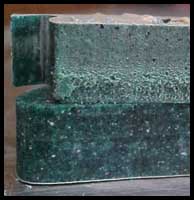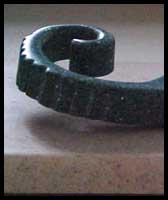

 Review of Seahorse
Plaque Pattern - SLP2SHP
Review of Seahorse
Plaque Pattern - SLP2SHP
by Pat Lapori
Pattern developed by Barry Gross of BG Artform's
2189 Philip Drive
Bensalem, PA 19020
How to use Corian with a Scrollsaw. This
was something I tried several years ago and was never very happy
with the results. I had a lot of difficulty then cutting it.
Not because of its hardness, but because it would continually
melt back together behind my blade. Even when I managed to go
slow enough to avoid the melting, the cut edge always looked
very rough and just not very pretty.
So, here I am attempting it again. Only this time with some directions from a master Corian artist, Barry Gross. And also armed with some blades that I was told would do the job. All I could say while using the blades was "Wow!". What a difference a blade makes. I had to take this picture just to illustrate what I mean. The bottom piece of Corian was cut with Barry's blades. The top piece was cut with a regular #5 blade at the same speed. These are both fresh cuts. No sanding has been done. I think you can see a great deal of difference using the proper blade has made.
The instructions said to go slow, at no more than a medium speed. Well, my saw goes up to 1700 so I slowed it down to 800 and tried that. It worked just fine. I intend to experiment with these blades to see just how fast I can go, but I was more than pleased with the appearance of the cut at 800.
Barry's instructions also said to put masking tape on the Corian. Since my first attempt at cutting Corian, I have learned about using 'Packing Tape' to help lubricate blades while cutting. This is also another experiment I intend to do at a later time. For this project, I did use the masking tape as Barry instructed.
Following the instructions given, the next step was to round over the edges of the project. Barry suggested a router with a 1/4" round over bit. I took one look at that set up and decided to use a much smaller round over bit - 1/8". Parts of the sea horse looked pretty small to be tackling with the bigger bit, and I am still pretty much a chicken when it comes to using the bigger tools. The smaller bit worked pretty well and got into all of the edges. Someone with more nerve than me could probably put a really pretty edge to the background plaque. Mine is simply rounded over to give it a softer look.
Another problem that I had with the Corian originally, was a dire lack of knowledge in just how to go about finishing the material. I was afraid to sand it and leave all kinds of scratches on the material. This time we sanded away, also per the instructions. Up to and including wet sanding. OK, so I am still a novice at some of this stuff. Had to ask my husband just how you use wet sandpaper. But with a little help from my better half I got that job done too.
Now I had everything pretty smooth, but I like a really nice shiny look to a project, so then we headed to the polishing wheel and buffed the entire thing. It looks great now. I will admit that someone who is more used to doing intarsia or carving could probably do a lot more with shaping the piece. This was enough for me. I had no problems with using the router on the material, or with the drill. After the warnings of slowing the scroll saw blade down though, I did double check on the speed I used these tools with. I still wanted to keep any melting of the Corian to a minimum.
Per the instructions "now the real fun begins". It was time to "Cook the Corian". I pre-heated the oven to 340 degrees and put the seahorse on a cookie sheet and baked it for 12 minutes (Barry says 10 to 15). Holding my breath and checking probably more often than I should have. I got worried that I shouldn't have polished it before doing this step, cause a lot of bubbles appeared all over the surface. But that was just at the beginning. By the time I took it out of the oven they were gone and it still looked nice. HOT, but nice.
 Do use heavy
oven mitts to handle the material at this stage. Corian gets
very HOT. I had talked to a friend who had tried this before
me who said he had no trouble bending the material, but wasn't
prepared to support the bend while the Corian cooled, so he lost
a lot of his shaping and had to redo the baking step. I had several
scraps of thin plywood ready to use as shims while everything
cooled off. It really does bend quite easily. I didnít
really push it to an extreme, but you might be able to get some
very interesting shapes in this while it is hot. But, once I
got everything about how I wanted it, I put some shims under
the raised portions and waited for everything to cool off. 12
minutes to heat it all up and almost an hour before it felt "normal"
(not warm). So be prepared to let things sit for that long.
Do use heavy
oven mitts to handle the material at this stage. Corian gets
very HOT. I had talked to a friend who had tried this before
me who said he had no trouble bending the material, but wasn't
prepared to support the bend while the Corian cooled, so he lost
a lot of his shaping and had to redo the baking step. I had several
scraps of thin plywood ready to use as shims while everything
cooled off. It really does bend quite easily. I didnít
really push it to an extreme, but you might be able to get some
very interesting shapes in this while it is hot. But, once I
got everything about how I wanted it, I put some shims under
the raised portions and waited for everything to cool off. 12
minutes to heat it all up and almost an hour before it felt "normal"
(not warm). So be prepared to let things sit for that long.
The close up is just to illustrate some of the curve that I managed to get into the piece as a result of baking the Corian. However did Barry come up with this idea? Throwing a piece of Corian into the oven would not have been my first thought in trying to do something different with this material. This is truly an ingenious idea.
Attaching the sea horse to the background plaque was the only place where I couldn't follow the directions. I had drilled the necessary holes, but when I tried to place the correct screw in the holes I couldn't get it to work. The hole was just a little smaller than the screw and it wouldn't turn into the hole and stay, it just enlarged the hole. So I cut off a short length of dowel rod and glued that into place. It's working.
I would highly recommend either this or a similar project from BG Artforms if you have never worked with Corian. The detailed instructions alone are worth the price of the pattern. And I would HIGHLY RECOMMEND that you get some blades from Barry also. They work really well and will save you oodles of frustration and sanding time. Now for my next Corian project, I want to try the snake puzzle Barry has made. It looks like he has glued several pieces of Corian together to make up that red stripe on the side. You can see a picture of this project on Barry's web page.
Pat Lupori
Editor's Note: Pat Lupori runs the Scrollsaw Association of the World website.